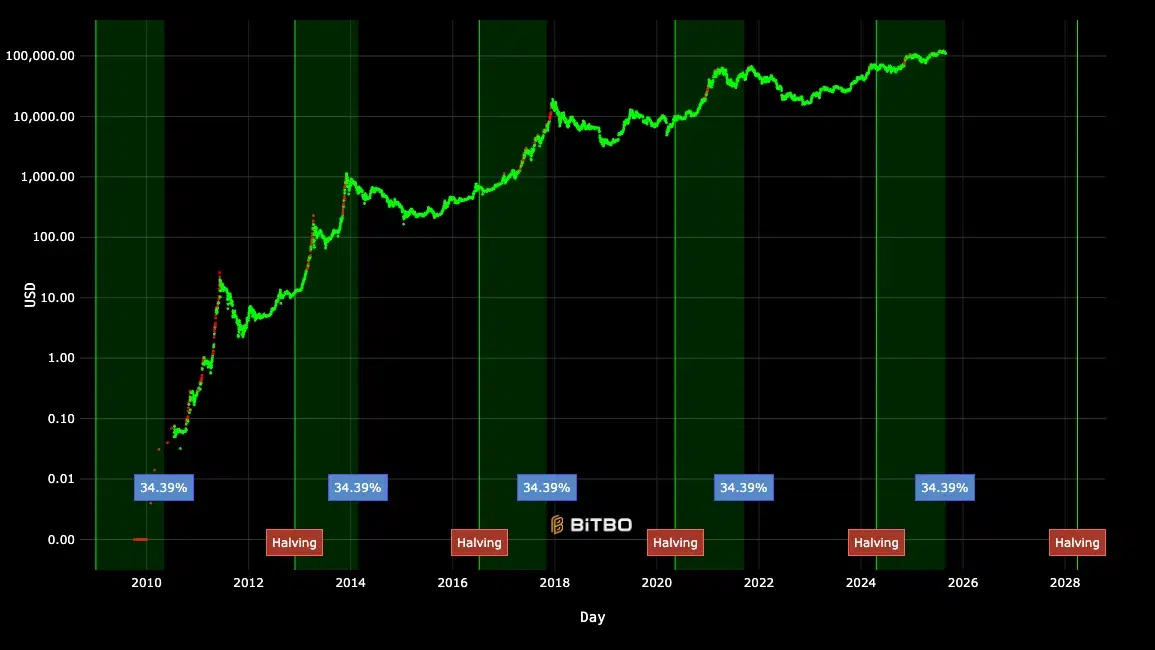That $500,000 price tag for Bitcoin keeps getting thrown around, and it’s no longer just whispers in niche forums. Big-money players are piling in, the coin’s built-in scarcity is doing its job, and the wider economy seems to be playing along. Seasoned traders and venture capitalists are now openly betting on Bitcoin multiplying its value in the next five years.
However, for every booster, there’s a serious roadblock – From governments getting nervous to new tech that could break Bitcoin entirely. This isn’t a sure thing; it’s a high-stakes tug-of-war.
Can the halving do it again?
Bitcoin’s secret weapon has always been its built-in countdown clock. Every four years, the reward for mining new coins gets slashed in half, a hard-coded event called the “halving.” Look back at 2012, 2016, and 2020 – Each halving kicked off a wild market climb, with gains hitting 9,500%, 3,000%, and 700% in the cycles that followed.
Sure, the gains aren’t as explosive as they once were, but the basic math holds up. When supply shrinks and people still want in, prices tend to go up.

Source: Bitcoin Progress Chart/Bitbo
In fact, data crunchers at Glassnode have pointed out that even when everyone expects the pattern to fail, the market keeps rhyming with its past. The April 2024 halving reset the clock. And, if history is any guide, we might see the fireworks peak in late 2025.
Wall Street’s arrival changes everything!
What’s different this time? Wall Street finally showed up to the party. The new Spot Bitcoin ETFs in the United States weren’t just a ripple. Instead, they were a floodgate, opening the doors for everyday investment portfolios to get a piece of the action.
By the middle of 2025, money pouring into these funds blew past all of 2024’s numbers, topping $14.8 billion. All told, U.S ETFs have now locked away about 6% of all Bitcoin, yanking a huge chunk of coins off the open market. And, the appetite is growing too.


Source: Coinglass
- Corporate Piggy Banks – Michael Saylor’s company, now called Strategy Inc., has gone all-in, hoarding an eye-watering 629,376 BTC worth over $72 billion. Now more than 70 other public companies are following suit, using Bitcoin as a shield against a devaluing dollar.
- The Pension Fund Thaw – The real giant is just starting to stir. Giant, slow-moving pension funds are finally allocating slivers of their massive portfolios to Bitcoin. We’re seeing it from the State of Wisconsin’s investment board, Michigan’s retirement system, and even a large UK pension plan. The biggest signal yet came when CalSTRS, the third-largest pension fund in the U.S., bought into MicroStrategy, giving them a backdoor pass to Bitcoin.
This kind of big-money buying changes the market’s behavior, with institutions now stepping in to buy the dips that used to cause retail investors to panic and sell.
Outlaw to asset – Rules of the road get clearer
For years, investing in crypto felt like the Wild West. That’s changing. In 2025, U.S. lawmakers finally started drawing clear lines in the sand with acts that set rules for stablecoins and digital assets, giving big investors the rulebook they’ve been waiting for.
A crypto-friendly White House has helped calm the nerves, and President Trump’s recent order green-lighting crypto in 401(k)s could pry open a $12.2 trillion pool of retirement savings, weaving Bitcoin into the financial fabric of millions of lives.
Landmines on the road to $500k
Alas, the climb to half a million dollars is littered with obstacles that could send the price tumbling.
A crowded field
Bitcoin isn’t the only game in town anymore. Faster, more flexible networks like Ethereum and Solana are attracting a lot of the new talent and money. As these competitors build out slicker technology, they could chip away at Bitcoin’s dominance.
Government-made crypto
Then there’s the government’s own version of digital cash. More than 80% of the world’s central banks are cooking up their own digital currencies. These CBDCs could either normalize the idea of digital money or become a state-controlled competitor designed to crowd Bitcoin out.
For now, the U.S. government is saying no to a digital dollar, but that could change.
Nightmare scenarios
Then you have the real “black swan” events, the ones that could crater the whole system –
- The quantum problem – Quantum computers, once science fiction, get closer every year. If one becomes powerful enough to crack Bitcoin’s security, trust in the entire network could evaporate overnight. Some researchers believe this could happen as soon as 2027. Moving Bitcoin to quantum-proof technology would be a gargantuan task.
- A global hammer – A total worldwide ban seems far-fetched, but what if all the major economic powers decided to clamp down at once? China already did it, proving it’s not impossible.
- An inside job – The network itself isn’t foolproof. A group of powerful miners could theoretically team up to hijack the system, a so-called 51% attack. And if Bitcoin fails to scale up to handle more users, people will simply abandon it for something that works better.
A wild gamble on a new kind of money
If Bitcoin actually hits $500,000, it won’t just be a number on a screen. It would mean a fundamental shake-up of who controls money and what we even consider valuable.
You have a shrinking supply, a tidal wave of new money from the financial elite, and governments finally writing the rules of the road. It all makes a powerful case for a much higher price. But anyone expecting a smooth ride is delusional. The threats are real—from faster crypto rivals to the ghost of quantum computing. The dream of a $500,000 Bitcoin feels more possible than ever, but it’s a high-stakes gamble built on a foundation that’s still being tested.
